Top 10 Lawn Mowers 2023
Join the millions that have trusted Haffprice.net to help them make smarter buying decisions. Let our independent expert reviews and data-driven shopping recommendations help you find the lawn mower that’s right for you.
#1

9.8
Powerworks XB 40V Electric Self-Propelled Lawn Mower
- Type: Self-propelled
- Power Source: Cordless 40V + 45 min run time
- Height Adjustments: 7
- Cutting Deck: 21″
- Clippings: Mulch, side discharge, rear bag
- Weight: 78.6 lbs
Picked by 320 people this week!
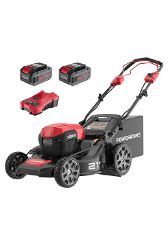
#2

9.5
Litheli Cordless Lawn Mower
- Type: Push
- Power Source: Cordless 20V + 35 minute run time
- Height Adjustments: 5
- Cutting Deck: 13″
- Clippings: Rear bag
- Weight: 27 lbs
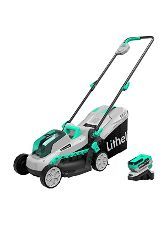
#3

9.1
EGO Power+ Cordless Lawn Mower (LM2101)
- Type: Push
- Power Source: Cordless 56V + 45 minute run time
- Height Adjustments: 6
- Cutting Deck: 21″
- Clippings: Side discharge, rear bag, mulch
- Weight: 55.3 lbs
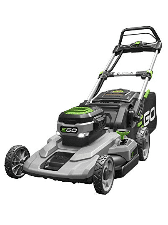
#4

9.0
Craftsman Push Gas Lawn Mower (M105)
- Type: Push
- Power Source: Gas 140cc engine
- Height Adjustments: 6
- Cutting Deck: 21″
- Clippings: Side discharge, rear bag, mulch
- Weight: 72 lbs
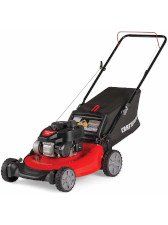
#5

8.9
Snapper XD Cordless Lawn Mower (21SPWM82K)
- Type: Self-propelled
- Power Source: Cordless 82V + 45 minute run time
- Height Adjustments: 7
- Cutting Deck: 21″
- Clippings: Side discharge, rear bag, mulch
- Weight: 80.9 lbs
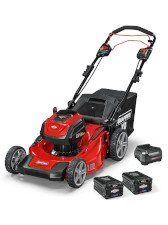
#6

8.7
WORX Power Share Cordless Lawn Mower (WG779)
- Type: Push
- Power Source: Cordless 40V + 60 minute run time
- Height Adjustments: 6
- Cutting Deck: 14″
- Clippings: Rear bag, mulch
- Weight: 35.3 lbs
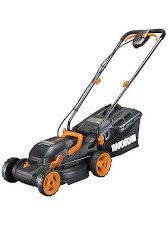
#7

8.6
Greenworks Cordless Lawn Mower (25322)
- Type: Push
- Power Source: Cordless 40V + 45 minute run time
- Height Adjustments: 5
- Cutting Deck: 16″
- Clippings: Rear bag, mulch
- Weight: 37.5 lbs
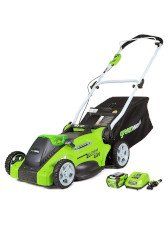
#8

8.5
Greenworks Twin Force Cordless Lawn Mower (25302)
- Type: Push
- Power Source: Cordless 40V + 45 minute run time
- Height Adjustments: 5
- Cutting Deck: 20″
- Clippings: Rear bag, mulch
- Weight: 42.5 lbs

#9

8.3
Greenworks Electric Lawn Mower (25022)
- Type: Push
- Power Source: Corded electric 12 amp motor
- Height Adjustments: 7
- Cutting Deck: 20″
- Clippings: Side discharge, rear bag, mulch
- Weight: 56 lbs
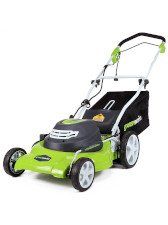
#10

8.2
Greenworks Elite Cordless Lawn Mower (M-210-SP)
- Type: Self-propelled
- Power Source: Cordless 40V + 60 minute run time
- Height Adjustments: 7
- Cutting Deck: 21″
- Clippings: Side discharge, rear bag, mulch
- Weight: 70 lbs
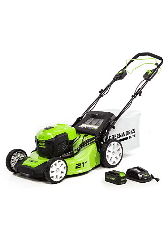
We also considered 10 other:
Our Top Choice
#1

9.8
Powerworks XB 40V Electric Self-Propelled Lawn Mower
- Type: Self-propelled
- Power Source: Cordless 40V + 45 min run time
- Height Adjustments: 7
- Cutting Deck: 21″
- Clippings: Mulch, side discharge, rear bag
- Weight: 78.6 lbs
Picked by 320 people this week!

About Our Rankings:
Our recommendations are based on expert comparisons between available products in each product category. For lawn mower, we chose the topics that we think matter most to our users, and provide consise, clear comparisons of the features that matter. Our rankings change day-to-day based on our proprietary algorithms, that crunch data to identify top-performing products and tailor recommendations to exactly what our readers are looking for.

93
Models
Evaluated

19
Topics
Considered
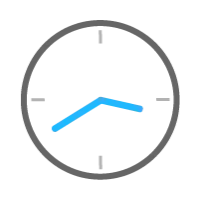
43
Hours of
Research

67,582
Purchases
Analyzed
Lawn Mower Buyer's Guide
Enhance your home’s curb appeal with a perfectly cut lawn. You can get the job done quickly and efficiently with the right lawn mower. Whether a walk-behind or a riding mower, a lawn mower with convenient features and easy maneuverability can take the hassle out of the weekly chore and even make it enjoyable. Depending on the size of your property, you can enjoy a few hours or just a few minutes of work made much more efficient with the cutting-edge lawnmowers that are available today. Choosing an electric or battery-powered mower can even eliminate unpleasant exhaust odors.
When your grass is trimmed, your yard looks more presentable and welcoming, making it easier to walk around your property and enjoy time outdoors with your family and friends. But keeping your lawn mowed is also beneficial for your grass. It ensures that it grows evenly throughout your yard, that the blades are at the right height to stay lush and healthy, and prevents weeds from spreading. The best lawn mower for your yard will give your grass an even cut, be easy to maneuver around obstacles and up hills, and make it simple to collect grass clippings. Many modern lawn mowers are easy to start on the first try, stopping lawncare stress and making the perfect lawn achievable.
The right type of lawn mower for you will depend mainly on the size and layout of your property. You’ll also want to consider specific features and functions that can make the lawn mowing chore easier. In this article, we’ll discuss the different types of lawnmowers and their power sources. We’ll also talk about features that make mowing more convenient, including the cutting deck, height adjustment, and how clippings are handled.
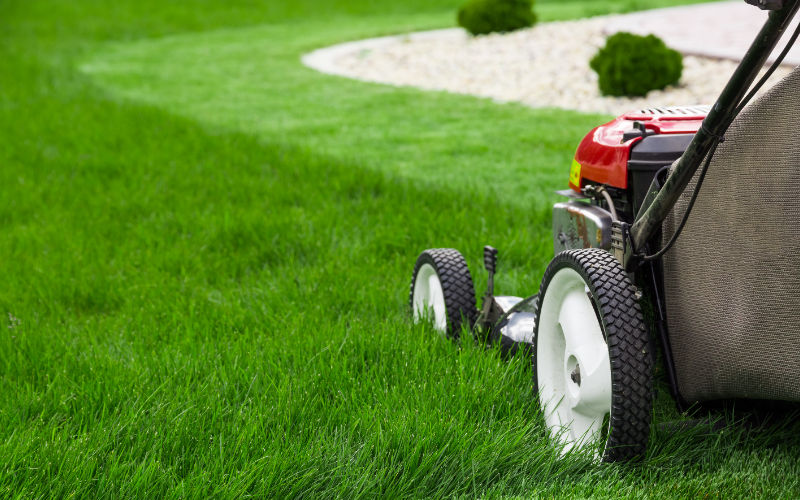
Considerations


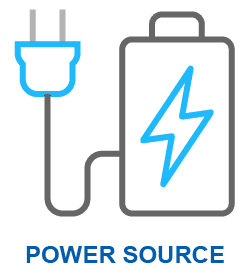

Type
There are two types of lawnmowers: walk-behind and riding. These two can be further broken down into categories, which we’ll more deeply explore in a minute. The choice of a walk-behind or riding mower should depend on the size of your yard. Generally, you should choose a riding mower for any yard over ¼ of an acre. This will make finishing the task quicker, and it’s much less physically demanding on you.
- Riding Mowers & Lawn Tractors: On these lawn mowers, the operator is seated rather than walking behind the machine. Since they have a larger cutting path and don’t require any physical exertion, they allow you to cover more ground quicker than a walk-behind mower. These types are ideal for yards above ¼ acre and up to about 2 acres. They’re also suitable for elderly people or those with physical impairments. A riding mower’s engine is usually gas-powered, but you can also find battery-powered options. The difference between a riding mower and a lawn tractor is primarily the location of the cutting deck. On a lawn tractor, the cutting deck is mounted in the middle on a lawn tractor, and on a riding mower, it’s mounted at the front.
- Zero-Turn Mowers: This is a type of riding lawn mower that has a zero turn radius, so it offers precise maneuverability, which is beneficial for mowing around bushes, flower beds, and other obstacles in your yard. On most models, you sit, but on some, you stand on a deck at the rear of the mower. Z-turn mowers are ideal for larger properties because they can move faster than traditional riding mowers. They also have many customization options and attachments that make lawn mowing more convenient. However, there are typically more expensive than riding mowers and can be unsafe on uneven surfaces or slopes.
- Walk-Behind Mowers: These are ones you walk behind rather than ride, so they require a degree of physical effort. Walk mowers are best for smaller yards under ¼ acre. They’re lighter and more maneuverable than riding mowers since they can easily be manipulated into tight quarters. Walk-behinds may be self-propelled or push mowers.
A self-propelled mower has a drive system that propels it forward, so all you have to do is steer it. It’s excellent for hills or mowing with a bag. The drive system may be front-wheel, rear-wheel, or all-wheel. Front-wheel is best for level ground, rear-wheel for hills, and AWD is best for rough surfaces.
Push mowers rely on manual effort to move forward. They’re typically lighter and easier to maneuver than self-propelled models, and they’re more affordable. However, they do require more manual effort. Like self-propelled mowers, they’re available in gas, electric, or battery-powered options. - Manual Lawn Mowers: Also called reel lawn mowers, these old-fashioned mowers do not have a motor and are operated by manual force, so using one can be a bit of exercise. They cut grass using a blade or blades that rotate as you push the mower forward. Because they are manually operated, they’re best for small yards. They’re more economical than electric or gas mowers, are quiet-running, do not create emissions, and are simple to maintain. However, they do take more effort, and your lawn may need more frequent mowing to keep it short enough for the mower to be effective.
- Robot Lawn Mowers: A robot lawn mower operates with the same level of autonomy and easy programmability as a robot vacuum does, except a robot lawn mower’s job is to cut grass. It uses special sensors to automatically cut a path around your yard, moving around obstacles and sticking to your set parameters. Many robot mowers automatically return to their charging port when done or when it starts to rain. The main advantage of a robotic lawn mower is that you can maintain a nice-looking lawn without putting any time into it. You can set the robot mower on a schedule or manually start it. Robotic mowers are lightweight, weighing around 30 pounds, so they won’t wear on the turf. And since they’re battery-powered, they share the same benefits as a battery-powered mower; they’re gas-free, quiet, and eco-friendly. But since they run on a limited battery, they’re best for small to medium-sized yards up to ½ acre. The drawbacks are that robot lawn mowers are expensive initially, can be complex to install, and may have trouble in complex yards, like ones with holes or steep slopes.
Power Source
Aside from manual reel mowers, lawn mowers have three power sources you can choose from gas, electric, or battery. Both walk-behind and riding mowers are available with each power source. When choosing one, consider the size of your yard, your access to resources, and how much time you want to spend maintaining your lawn mower.
- Gas: Powered by gasoline held in a fuel tank, this is the most common type of lawn mower. Gas mowers offer the most power (torque), unlimited range, and unlimited runtime (granted, you have enough gas to keep going), so they’re ideal for larger yards, thick grass, and various sloped terrains. They’re more versatile than electric and battery-powered mowers, are often more durable, and have a longer lifespan. However, they create foul-smelling emissions, so they’re less eco-friendly and require more maintenance. This includes changing spark plugs and air filters, checking oil levels, and sharpening blades.
- Corded Electric: Corded electric lawnmowers run on electricity supplied through a power cord connected to an outlet. They only come in walk-behind types, which can be self-propelled or push. Electric mowers are considered a green option for environmentally-conscious homeowners since they do not create emissions. They’re lightweight, maneuverable, quiet-running, and can save money on gas. However, the drawback is that you are tethered to a cord, so the range is limited. For this reason, electric mowers are best for small yards.
- Battery-Powered: These types of mowers are powered by a battery that you recharge with an electrical outlet between uses. They can be walk-behind or riding mowers. Since batteries offer a limited runtime, these types of mowers are best suited for small to medium-sized yards. Most run for 45-60 minutes at a time. They provide significantly less torque than gas-powered mowers, so they may not meet the challenge of tall or thick grass. However, these are an ecological choice since they have zero carbon emissions. Like corded electric mowers, they’re lightweight, quiet-running, and cost-saving. They also offer the ultimate maneuverability since you are not connected to a cord.
Height Adjustments
The cutting height of a lawn mower indicates how tall the grass will be after it’s cut. Most mowers, riding and walk-behind, have height adjustment controls so you can choose how high your grass will be after the cutting job is done. In the fall or during dry spells, many people choose to leave their grass taller to conserve moisture. Cutting a lawn too low, or “scalping” it can harm the grass’s health. The normal cutting height for most lawns is around 3”. On most mowers, height adjustment is done by moving the blades up or down by raising or lowering the cutting deck. This is usually done with a lever for both electric and gas-powered mowers, though the lever may be in different places. Most mowers offer heights from 1.5” – 4”, although some simpler models have only high and low settings.
Cutting Deck
The cutting width of a lawn mower refers to how wide of a strip the mower cuts in one pass. A lawn mower with a wider cutting width can cut a lawn faster. The cutting width is determined by the cutting deck, which is the main “body” of the lawn mower. It houses the blades and protects the operator and motor from them. Decks are often either fabricated from heavy plate steel or stamped from lightweight metal. The best mower decks have an aerodynamic design that lifts the grass to the cutting chamber and evenly discharges it. Deck width refers to your cutting path’s width, not the deck housing’s total width.
Cutting decks typically range from 18”-36” for walk-behind mowers, 36”-54” for riding mowers, and 60”-72” for zero-turn mowers. For smaller yards up to ½ acre, a deck size of 40” or fewer is acceptable. A 42”-48” deck is appropriate for lawns ½-2 acres. For a lawn 3 acres or larger, aim for a 50” or larger cutting deck, which will usually be on a zero-turn mower.
Clippings
A lawn mower’s function is determined by what it does with the grass clippings after cutting them. Most mowers can mulch clippings, discharge them, or bag them. Two-function mowers mulch and bag, while three-function mowers can do all three. All three functions can be found on both walk-behind and riding mowers.
- Mulch: Mulching mowers don’t provide “mulch” in the conventional sense; instead, they repeatedly cut and recut grass blades into tiny pieces. The pieces are dropped back onto the ground, where they can break down and release nutrients that feed your lawn. Since a mulching mower produces fine clippings, they do not have to be removed from the lawn, which results in less work for you.
- Discharge: The most common type of clipping function, a traditional mower cuts grass and propels the clippings through an exit channel. This can be either on the side or rear. Rear-discharge mowers send clippings out the back of the deck in a broad pattern, reducing the likelihood of rocks and debris shooting out at high speed. They don’t leave the trails of clumped clippings as you see with side-discharge mowers. Side-discharge mowers direct clippings on the side of the mower and leave them in a pile as you go. With a side-discharge mower, you need to plan your cutting path to avoid blowing clippings into flower beds, on sidewalks, or against other obstacles.
- Bagging: With a bagging function, clippings are directed into a bag attachment, usually through the side-discharge chute. If the grass is tall, leaves are present, or you want to prevent diseases and weeds from spreading, bagging your clippings is a good option. It can lower allergens and keep your lawn looking cleaner. However, if you are bagging your clippings, you must stop to empty the bag more often. On two- and three-function mowers, you often have the option to remove the bag for straight-to-ground discharge.
Weight
Considering weight is important when choosing a lawn mower, especially if looking for a walk-behind model. The elderly or those with disabilities may have difficulty maneuvering a heavy lawn mower. If you need to lift your mower for storage, you will also want a lighter, more manageable model.
Manual lawnmowers are often the lightest, weighing only around 50 pounds. Gas-powered and electric walk-behind mowers may be heavier, and the weight usually depends on the type of motor or battery used. Electric mowers can weigh as little as 30 pounds and as much as 150. The lighter models will be easier to push across the yard. Gas-powered mowers weigh between 80-90 pounds. If you choose a riding lawn mower, weight is usually not an issue since you will not be manually moving the mower. Riding mowers typically weigh between 300-600+ pounds. Consider purchasing ramps if you need to move your riding mower in and out of a raised spot. Lastly, you should note that many of today’s lawn mower models are foldable to ensure that storing them is as easy as possible.

FAQS
How should you store a lawn mower?
The best place to store a lawn mower, riding or walk-behind, is in a dry place safe from the elements. You can store a lawn mower in a shed, garage, barn, or basement. If you must store your lawn mower outdoors, raise it above the ground to allow air to circulate and prevent it from getting wet. Cover it tightly with a sturdy tarp. The mower should stay completely dry and not exposed to wind or freezing temperatures. If storing your lawn mower for the winter, remove the battery, clean it of grass, mud, and debris. Add stabilized fuel or empty the fuel tank. A winterized lawn mower can be stored vertically to save space.
How often should you sharpen lawn mower blades?
Over time, lawn mower blades get dull from usage. Generally, you should sharpen lawn mower blades twice per season or after 25 hours of use. This is regardless of your type of lawn mower or power source. You should also sharpen your blades after hitting rocks or other hard objects since this can dent or nick your blades. You can inspect your blades to see if they need sharpening or look to your lawn for indications. Uneven grass heights, missed patches, and grass that looks torn or brown on the tips are signs that your blades are dull.
Can you cut really long grass with a lawn mower?
Although you can cut really long grass with a lawn mower, it is not recommended that you do it often. If grass is too long, you can risk damaging your lawn mower. It can get clogged and possibly overheat. Ensure your machine is in perfect working order before tackling extremely long grass. Whether you use a riding mower or a walk-behind, set your mower height at the highest setting to make the first pass, then repeat at a lower setting if desired.
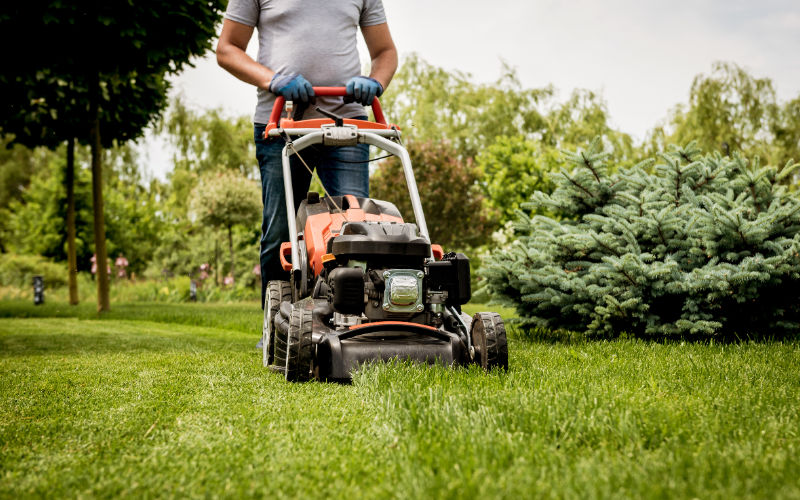
ABOUT BUYER'S GUIDE
Navigating the many choices for every consumer purchase can be challenging. Our team spends hours doing research, combing through forums, and reading consumer reviews on even the most basic of household items, and we summarize that information in clear, precise comparisons.
Join the millions that have trusted Haffprice.net to help them make smarter buying decisions. We help our readers spend their money wisely and find the right product to suit their specific needs. Our independent expert reviews and data-driven shopping recommendations empower you find the product that’s right for you.
We leverage user data to understand decision-making and put the best products in front of each user. We tailor our comparisons to what matters to our user’s needs, specific or broad. We keep our content up to date, we are constantly looking for new merchants and products to compare, and we are quick to remove any that are outdated or no longer meeting our standards.
Our rankings change day-to-day based on our proprietary algorithms that crunch data to identify top-performing products and tailor recommendations to exactly what our readers are looking for.

Written By Ryan W.
Ryan graduated with a degree in journalism and spent years building his writing career in the tech media field. An avid fan of gadgets and tech in general, Ryan has spent years testing and reviewing a wide array of devices. He specializes in reviewing everything from laptops and smartphones to more niche items like smart home devices and security cameras.
This site is a free online resource that strives to offer helpful content and comparison features to its visitors. Please be advised that the operator of this site accepts advertising compensation from companies that appear on the site, and such compensation impacts the location and order in which the companies (and/or their products) are presented, and in some cases may also impact the rating that is assigned to them. To the extent that ratings appear on this site, such rating is determined by our subjective opinion and based on a methodology that aggregates our analysis of brand market share and reputation, each brand’s conversion rates, compensation paid to us and general consumer interest. Company listings on this page DO NOT imply endorsement. Except as expressly set forth in our Terms of Use, all representations and warranties regarding the information presented on this page are disclaimed. The information, including pricing, which appears on this site is subject to change at any time.




